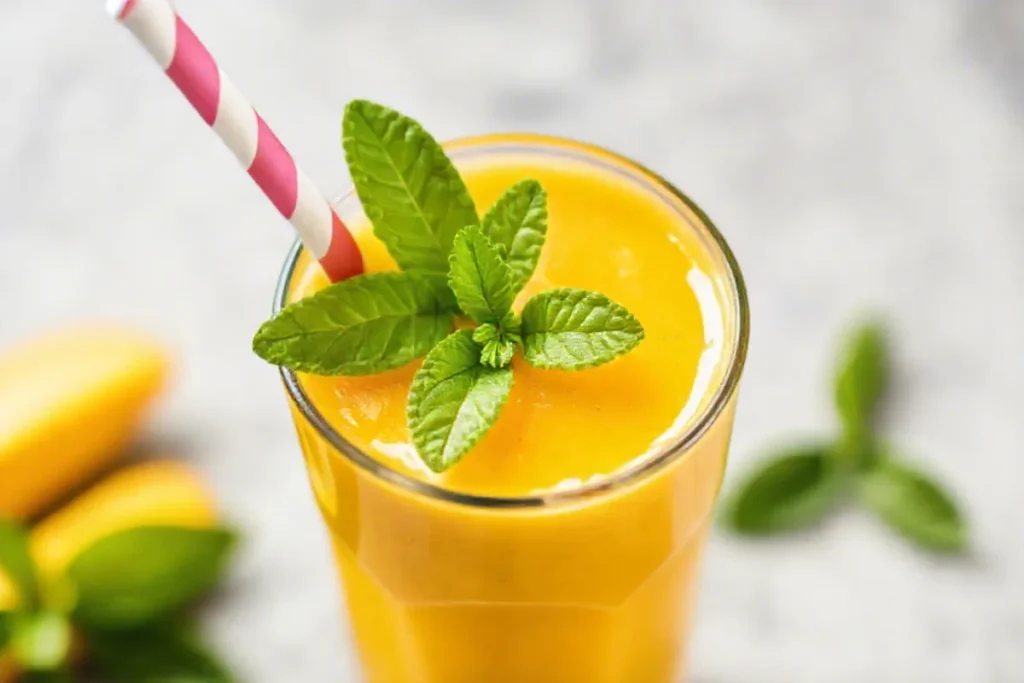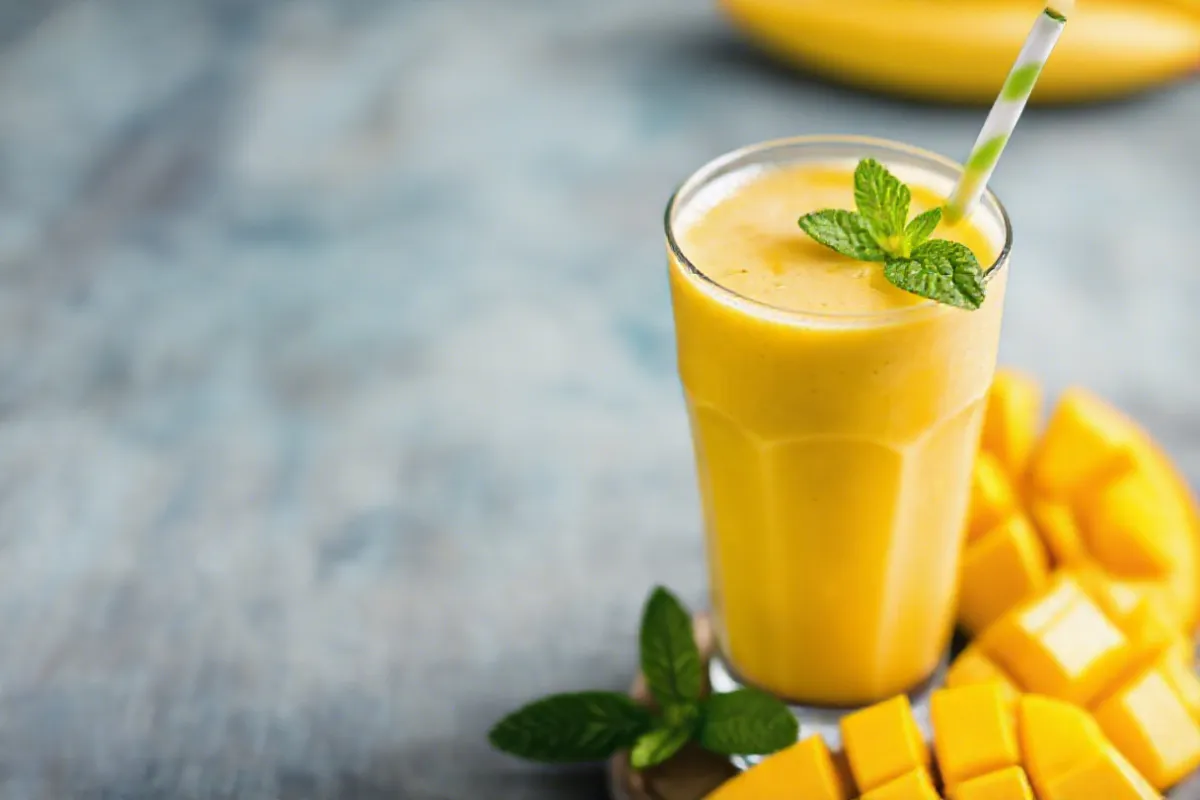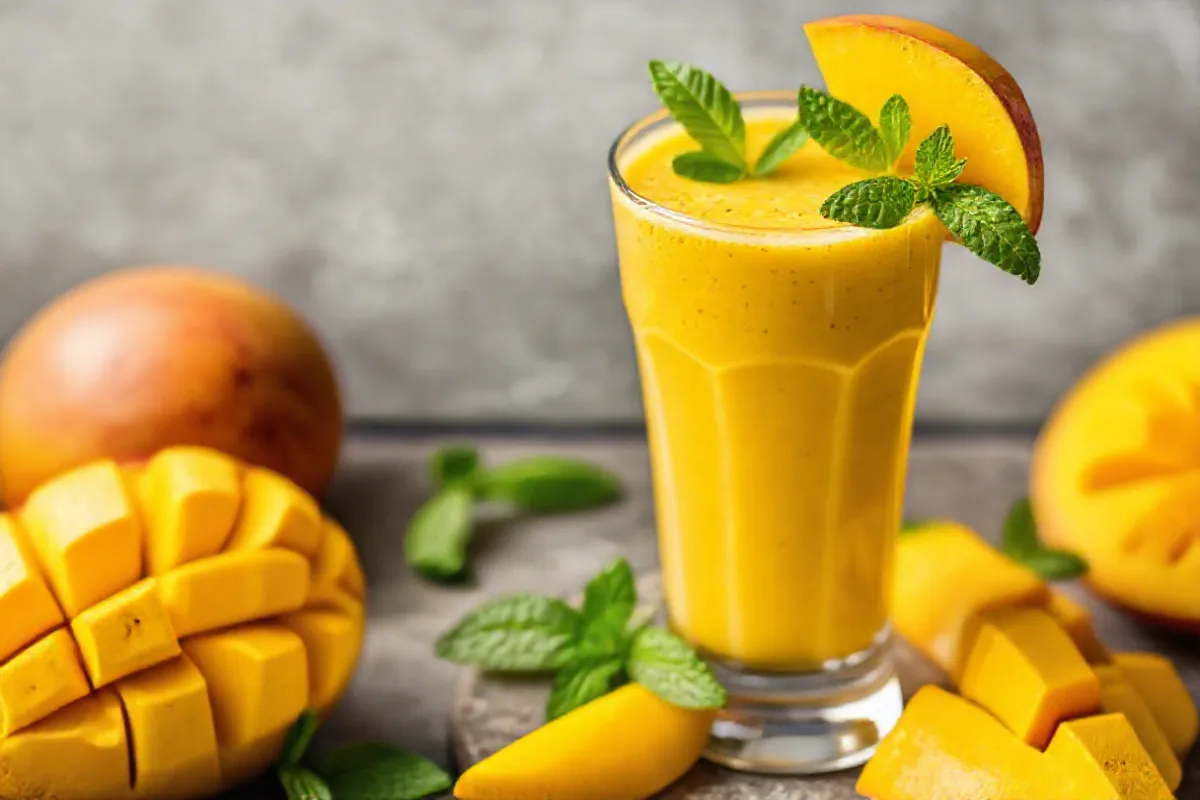Mangoes are not only delicious but also packed with nutrients, making them a perfect choice for a refreshing and healthy smoothie. In this guide, we will explore everything you need to know about making the perfect smoothie mit mango, from choosing the best ingredients to exploring various recipe variations. Whether you’re a smoothie enthusiast or a beginner, this comprehensive guide will help you create the most delicious mango smoothie you’ve ever tasted.
Introduction to Mango Smoothies
Mangoes are rightfully referred to be the “king of fruits,” and with good reason. Their sweet, tropical flavor is loved by many, and they are incredibly versatile in the kitchen. A mango smoothie is not just a treat for your taste buds but also a powerhouse of nutrients that can contribute to a healthier lifestyle.
Mangoes are rich in vitamins, particularly vitamin C and vitamin A, which are essential for boosting the immune system and maintaining good vision. Mangoes are also a great source of dietary fiber, which facilitates digestion. Combining mangoes with other ingredients in a smoothie can create a delicious, nutritious beverage that is perfect for any time of day.
For detailed nutritional information about mangoes, check out the Mango Nutrition Facts.

Essential Ingredients for the Best Mango Smoothie Recipe
To create the perfect smoothie mit mango, you need to start with the right ingredients. Here’s a breakdown of what you’ll need:
Fresh vs. Frozen Mango for Your Healthy Mango Smoothie
The star ingredient of any mango smoothie is, of course, the mango. You can use either fresh or frozen mango, depending on what you have available.
- Fresh Mango: Fresh mangoes offer a vibrant flavor and can be particularly good if you find them in season. However, they require peeling and chopping, which can be time-consuming.
- Frozen Mango: Frozen mango is convenient, as it’s already peeled and chopped. It also helps create a thicker, frostier texture for your smoothie. Plus, frozen mangoes are available year-round, making them a reliable option.
For tips on selecting the best mangoes, visit the National Mango Board’s guide on How to Choose Ripe Mangoes.
Adding Banana for a Creamy Mango Banana Smoothie
Bananas are often used in mango smoothies because they add a creamy texture and enhance the sweetness of the mango. They also provide additional nutrients, such as potassium, which is essential for heart health.
Liquid Options for a Vegan Mango Smoothie or a Dairy-Based One
The liquid component of your smoothie is crucial for blending the ingredients smoothly. Here are some options:
- Water: Simple and calorie-free, water is a good option if you’re looking to keep your smoothie light.
- Dairy Milk: Adds creaminess and a subtle richness to your smoothie. It’s a good source of calcium and protein.
- Non-Dairy Milk: For those who are lactose intolerant or vegan, non-dairy milk such as almond, oat, or coconut milk is an excellent choice. Each type of non-dairy milk offers a unique flavor profile and nutritional benefits.
Using Ice to Achieve the Perfect Texture for Your Frozen Mango Smoothie
Adding ice to your smoothie helps to create a frothy, thick texture. It’s especially important if you’re using fresh mango, as it compensates for the lack of frozen fruit. However, if you’re using frozen mango, you can reduce or even skip the ice, depending on your preference.
Optional: Fresh Lemon Juice to Enhance the Flavor of Your Tropical Mango Smoothie
A splash of fresh lemon juice can brighten the flavors in your smoothie, adding a refreshing tang that balances the sweetness of the mango and banana. Lemon juice is optional but highly recommended if you want to elevate the flavor profile of your smoothie.
Health Benefits of a Mango Banana Smoothie
Mango smoothies are not only delicious but also incredibly nutritious. Here are some of the key health benefits:
Rich in Vitamins and Antioxidants: Healthy Mango Smoothie
Mangoes are packed with vitamins A and C, both of which play a vital role in maintaining a healthy immune system. Vitamin A is also essential for good vision, while vitamin C helps in collagen production, which is important for skin health.
High in Fiber: Vegan Mango Smoothie Benefits
Dietary fiber, which improves digestion and helps ward off constipation, is abundant in mangoes. The fiber in mangoes also helps you feel full longer, making a mango smoothie a great option for a satisfying breakfast or snack.
Supports Heart Health with a Mango Banana Smoothie
Bananas, commonly used in mango smoothies, are rich in potassium, a mineral that is crucial for maintaining healthy blood pressure levels. Potassium helps counteract the effects of sodium in the diet, which can help reduce the risk of heart disease.
Boosts Digestion: The Power of a Frozen Mango Smoothie
The fiber content in mangoes, combined with the digestive enzymes they contain, can help improve digestion. This makes a mango smoothie a soothing option for those with digestive issues.
How to Choose the Best Mangoes for Your Smoothie mit Mango
Choosing the right mango is key to making a delicious smoothie. Here’s how to pick the best ones:
Fresh Mango Selection Tips for a Healthy Mango Smoothie
- Color: Look for mangoes with a vibrant color. The skin should be mostly yellow or orange, with some red blush.
- Firmness: A ripe mango will give slightly when pressed. Avoid mangoes that are too soft or have wrinkles on the skin.
- Aroma: A ripe mango should have a sweet, fruity smell at the stem end.
Frozen Mango Considerations for a Frozen Mango Smoothie
If you’re using frozen mango, make sure it’s 100% mango with no added sugars or preservatives. Frozen mango chunks are available in most grocery stores and are a convenient option for making smoothies.
Organic vs. Conventional Mangoes in a Mango Smoothie Recipe
Organic mangoes are grown without synthetic pesticides and fertilizers, making them a healthier option. However, they can be more expensive than conventional mangoes. If organic mangoes are not available or are outside your budget, be sure to wash conventional mangoes thoroughly before use.
Basic Mango Smoothie Recipe
Here’s a simple and delicious recipe for a basic mango smoothie:
Ingredients for Your Vegan Mango Smoothie:
- 3 cups frozen mango (or fresh, if preferred)
- 1/2 banana (room temperature, broken into chunks)
- 1/2 cup water
- 1/2 cup milk (or non-dairy milk like almond or oat milk)
- 5 ice cubes (optional, depending on the desired thickness)
- 1 tablespoon fresh squeezed lemon juice (optional)
Instructions to Make the Best Mango Banana Smoothie:
- Add all ingredients to a blender, starting with the liquids.
- Blend until smooth. If the mixture is too thick, add a splash of additional water or milk.
- Pour into a glass and enjoy immediately!
Mango Smoothie Variations: Customizing Your Smoothie mit Mango
The basic mango smoothie is delicious on its own, but you can easily customize it with additional ingredients to suit your taste and dietary preferences.
Adding Greek Yogurt for a High-Protein Mango Banana Smoothie
If you’re looking to increase the protein content of your smoothie, try adding 1/4 to 1/2 cup of Greek yogurt. Greek yogurt not only boosts the protein but also adds creaminess to the smoothie. Keep in mind that you may need to add a little more liquid to achieve the desired consistency.
Incorporating Nut Butters into a Healthy Mango Smoothie
Nut butters like almond or cashew butter can add a rich, nutty flavor and provide healthy fats. Just one tablespoon can transform your smoothie into a more filling, nutrient-dense meal. However, be mindful that nut butters can slightly mute the mango’s flavor.
Using Alternative Fruits for a Tropical Mango Smoothie
If you want to experiment with different flavors, try swapping out some of the mango for other frozen fruits. Pineapple, peach, and mixed berries are all excellent choices that pair well with mango.
Adding Greens for a Nutrient-Packed Vegan Mango Smoothie
For an extra nutritional boost, consider adding a handful of greens like spinach or kale to your smoothie. The mild flavor of spinach blends seamlessly into the smoothie, while kale adds a slightly earthier taste. Both options increase the vitamin and mineral content without overpowering the mango flavor.
Storage Tips for Your Frozen Mango Smoothie
Smoothies are best enjoyed fresh, but if you have leftovers or want to prepare them in advance, here are some storage tips:
How to Store Smoothies for Later
Store your mango smoothie in an airtight container or a mason jar with the lid tightly sealed. Refrigerate for up to 24-48 hours. Keep in mind that the smoothie may separate as it sits, but this is perfectly normal. Simply shake or stir before drinking.
Re-blending and Refreshing Stored Smoothies
If your stored smoothie has thickened too much, you can re-blend it with a little more water or milk to restore its original texture. This is especially helpful if the smoothie has been sitting in the fridge for more than a day.
Freezing Mango Smoothies for Meal Prep
Mango smoothies can also be frozen for longer storage. Pour the smoothie into ice cube trays or freezer-safe containers. When you’re ready to enjoy, simply pour the frozen smoothie cubes into a blender and blend until smooth, adding a bit of water or milk as needed to reach the desired consistency. This method is perfect for meal prepping, allowing you to have a healthy mango smoothie ready in minutes whenever you need it.
Mango Smoothie for Different Diets
One of the great things about mango smoothies is their versatility, making them suitable for various dietary preferences and restrictions. Here’s how you can adapt the basic recipe to fit different diets.
Vegan Mango Smoothie Options
For a vegan version of the mango smoothie, simply use a non-dairy milk alternative like almond, oat, or coconut milk. You can also add a plant-based protein powder if you want to boost the protein content. The natural sweetness of the mango and banana means you don’t need to add any extra sweeteners.
Paleo-Friendly Mango Smoothie
If you’re following a paleo diet, you can easily enjoy a mango smoothie by using water or coconut milk as the base. Ensure that all ingredients are whole and unprocessed. Adding a spoonful of almond butter can also provide healthy fats, making your smoothie more filling and satisfying.
Low-Sugar Mango Smoothie Tips
For those watching their sugar intake, you can modify the mango smoothie recipe to be lower in sugar by reducing the amount of banana or substituting it with a lower-sugar fruit like berries. Additionally, using unsweetened almond milk or coconut milk can help keep the sugar content down while still maintaining a creamy texture.
FAQs About Mango Smoothies
Mango smoothies are popular, but you might have some questions about how to make them perfect every time. These are some common queries along with their responses.
Can I Use Fresh Mango Instead of Frozen?
Yes, you may use a fresh mango instead of a frozen one. However, if you use fresh mango, it’s recommended to add some ice cubes to achieve that thick, frosty texture typically associated with smoothies. Frozen mango chunks are more convenient and provide a consistency similar to a slushie.
What Milk Works Best for Mango Smoothies?
The choice of milk depends on your dietary preferences and the flavor profile you desire. Dairy milk adds creaminess and richness, while non-dairy options like almond, oat, or coconut milk offer different flavors and can make the smoothie lighter. Each type of milk can work well in a mango smoothie depending on what you’re looking for.
How Can I Make My Smoothie Thicker or Thinner?
To make your smoothie thicker, reduce the amount of liquid you add or use more frozen ingredients, like frozen mango or banana. If you prefer a thinner smoothie, simply add more water, milk, or juice until you reach your desired consistency.
What Are Some Other Fruits That Pair Well with Mango?
Mango pairs beautifully with a variety of fruits, including:
- Pineapple
- Peaches
- Strawberries
- Blueberries
- Oranges
Experimenting with these fruits can help you discover new flavor combinations that you love.
Can I Make Mango Smoothies Ahead of Time?
Yes, you can make mango smoothies ahead of time. For best results, store them in an airtight container in the refrigerator for up to 48 hours. If you want to prepare them even further in advance, consider freezing the smoothie in individual portions and blending them right before you’re ready to drink.
Mango Smoothie Serving Suggestions
While a mango smoothie is delicious on its own, you can elevate your experience with some thoughtful serving suggestions.
Best Times of Day to Enjoy a Mango Smoothie
Mango smoothies are versatile and can be enjoyed at various times throughout the day:
- Breakfast: A mango smoothie makes for a quick, nutritious start to your day. Add some oats or chia seeds for a more filling option.
- Post-Workout: The natural sugars and vitamins in mangoes can help replenish your energy after a workout.
- Afternoon Snack: A refreshing smoothie can be the perfect pick-me-up to get you through the afternoon slump.
Pairing Smoothies with Breakfast or Snacks
Pair your mango smoothie with other healthy options for a balanced meal:
- Whole-grain toast with avocado
- A handful of nuts or seeds
- A small bowl of Greek yogurt topped with granola and fresh fruit
How to Garnish Your Mango Smoothie
Garnishing your smoothie can make it more visually appealing and add extra flavor:
- Fresh mint leaves for a refreshing twist
- For extra nourishment, mix in some flaxseeds or chia seeds.
- A few slices of fresh mango or other fruits on top

Conclusion
Mango smoothies are a delightful and healthy way to enjoy the natural sweetness of mangoes. With the right ingredients and a bit of creativity, you can make a smoothie mit mango that’s perfect for your taste and dietary needs. Whether you’re looking for a quick breakfast, a post-workout recovery drink, or just a tasty treat, this guide has provided you with all the tools and knowledge you need to create a delicious, nutritious mango smoothie.
So grab your blender and start experimenting with different variations, and don’t forget to share your favorite creations with friends and family!





